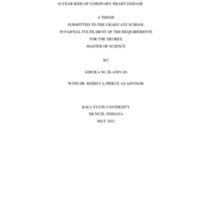Browse Exhibits (81 total)
Abdulgadir Elnajdi | Spatial analysis of lead-contaminated soil properties using geographic information system (GIS)

The study of the health issues caused by environmental factors such as lead-contaminated soil requires reliable information on soil properties' spatial distribution. Lead-contaminated soil resulting from gasoline, paint, and industrial pollution is still a severe source of lead for young children in the United States. Lead is associated with health risks such as kidney diseases, bone diseases, and affected regions inside the brain responsible for executive functions in the human body. Centers for Disease Control and Prevention (CDC) highly advise that public health measures start when a child's blood lead level is five µg/dL. A blood lead concentration (BLL) of greater than ten µg/dL at an early age could cause long-lasting health effects. In 2014, children in Indiana were screened for Lead, and approximately 4.3 % (0 1,765 out of 40,811) Hoosier children were at or above the CDC standard of five µg/dL (Health and Program, 2014). The lead levels found in Muncie's soil are concerning. The evaluation of the spatial distribution of soil properties [soil lead content, soil pH, soil texture, Etc.] is essential to assess the health concerns in Muncie, and it is one of the bases for decision and policymakers to make designs and strategies to fix the issues.
Researchers in environmental monitoring with geographic information system (GIS) can generate high-quality maps. The objective of this study is to investigate the interactions between total lead and bioaccessible Pb with blood lead levels of Muncie residents. Furthermore, examine the soil properties such as soil texture, pH, and organic matters to add more information about the possibility of lead mobility in Muncie's soil.
Faculty mentor: Dr. Adam Berland
Department of Environment, Geology and Natural Resources
Graduate
Adeola Olaniyan | A Comparison of Machine Learning Techniques in Predicting 10-Year Risk of Coronary Heart Disease

This study uses different supervised machine learning techniques to build predictive models to predict the 10-year risk of coronary heart disease. It also compares, identifies, and selects the model with the least test error rate and the highest prediction accuracy.
Faculty Mentor: Dr. Rebecca Pierce
Department of Mathematical Sciences
Graduate
Airhenvbahihea Edionwe | Bacteriophage control of Salmonella enterica in artificially contaminated 1%, pasteurized milk

Salmonella spp. are the number one causative agent of foodborne illnesses in the United States each year. Salmonella spp. have been isolated from various food matrices including eggs, poultry, milk, and beef. Bacteriophage are viruses of bacteria. Bacteriophage, also known as phage, insert their genetic material into their hosts, hijacking their DNA synthesis machinery in order to produce more phage inside the host cell. Bacteriophage have been considered an alternative to antibiotics because of this lytic ability to kill their hosts. The goal of this study is to identify novel Salmonella bacteriophage from raw dairy milk and assess the ability to infect its host. For this experiment, three bacteria were used; Salmonella enterica subsp. Enteriditis, Salmonella enterica subsp. Pullorum, and S1 (an uncharacterized Salmonella species isolated from raw dairy milk. Salmonella enterica subsp. Enteriditis was used as the host for the novel bacteriophage. Upon phage isolation, enrichment is performed to increase phage titers. The phage is then added to various densities of bacteria to assess its ability to control growth under optimal conditions. Results from this experiment will lead an insight into better biological control methods.
Facult mentor: Dr. John L. Mckillip
Biology
Undergraduate
Alex Detrich, Emily Seward, Madison Small, Kayla Ramsey, McKinzie Thurman, Colette Delawalla | Exploring Impulsivity, Negative Urgency, and Cannabis Use in College Students
Impulsivity is a multidimensional personality trait that captures non-planful, sensation-seeking, emotionally driven rash action (Whiteside & Lynam, 2001). Research assessing the relationship between impulsivity and substance use is plentiful and interdisciplinary, including investigation into brain patterns, biological differences between the sexes, and internal and external stimuli. However, different substances are associated with different dimensions of impulsivity, for example, excessive alcohol use is associated with excitement seeking (Gunn et al. 2013).
Negative urgency, or the tendency to act rashly under extreme negative emotions, is associated with substance use, internalizing problems, and other negative health related outcomes (Bardo, Weiss, and Rebec, 2018). The current study will use archival data to determine if a relationship exists between impulsivity and cannabis use and negative urgency and cannabis use, using the UPPS-P measure of impulsivity and the Cannabis Use Disorder Identification Test (CUDIT) to quantify cannabis use. The goal of this study is to understand the association of impulsivity and negative urgency with different levels of cannabis use. We expect that both impulsivity, broadly and negative urgency, as measured by the UPPS-P will be positively correlated with scores on the CUDIT (i.e., cannabis use).
Faculty Mentor: Tayla Lee
Psychological Science
Graduate/Undergraduate
Alex Thomas, Adam Gackenheimer, Zachary Criswell, Nathan Malitz | Finwell Apps Capstone

Given the profound success of applications such as Mint, it is apparent that budgeting softwares aid in the promotion of financial literacy, security, and growth. On a broad scale, apps like Mint can be an exceptionally helpful tool to users that have a basic understanding of their finances but need help in tracking spending. To avoid problems such as overwhelming users — something that applications like Mint can be guilty of — Finwell Apps seeks to teach financial literacy at an elementary level by providing simplistic and straightforward functionality with a streamlined UI. Sophisticated financial resources are provided throughout the user’s experience with the app to further enforce financial responsibility and growth.
Faculty Mentor: Huseyin Ergin
Computer Science
Undergraduate
Alexa Pellegrino | Associations Between Attachment Style, Reactive Aggression, and Emotion Regulation

Reactive aggression represents aggressive feelings and behaviors that are emotionally dysregulated, and thus are being expressed maladaptively (Card et al., 2008). Therefore, effective emotion regulation may be important for limiting reactive aggression (Daffern, & Bucks, 2012). Attachment styles predict who may act with more reactive aggression (Mikulincer et al., 2003). Hence, understanding the relationship and associations between adult attachment styles, emotion regulation abilities, and reactive aggression will allow clinicians to predict who will use problematic reactive aggression to target this aggression. These findings may inform and guide treatment and interventions by targeting emotion regulation skills and training to reduce these aggressive tendencies. The current study is designed to address the associations between: (1) emotion regulation and reactive aggression; (2) reactive aggression and adult attachment style; and (3) adult attachment style and emotion regulation.
Faculty Mentor: Dr. Thomas Holtgraves
Psychological Sciences
Graduate
Alexandra Doerner, Chloe Woodling, Elli Cole, Alexandria Epperly, Emma Dahlingaus | The Influence of Perseverance and Procrastination on Strategic Approaches to Learning

Grit is the perseverance and passion for long term goals (Duckworth et al., 2007). Perseverance has been linked self-regulated learning, lower levels of procrastination, and academic achievement (Wolters & Hussain, 2014; cite). Self-regulated learning, such as strategic learning approaches, has also been linked to better academic performance (Grøm Saele et al., 2017). In contrast, procrastination indicates a lack of self-regulation and is associated with poor academic performance. Therefore, it was hypothesized that first perseverance would predict higher strategic learning. The second hypothesis was procrastination would mediate the relationship between perseverance and strategic learning. College students (N= 127) completed the GRIT Scale, the ASSIST, and the Procrastination Scale. To investigate procrastination as a mediator of perseverance and strategic approaches to learning, a mediation analysis was conducted using PROCESS (Hayes, 2017). Gender was included as a covariate in the model due to past research (Voyer & Voyer, 2014), and significant relations to the dependent variables. The results supported the first hypothesis, perseverance significantly predicted strategic approaches to learning and accounted for 30% of the variance (R2 = .30, p < .01). The second hypothesis was also supported as procrastination partially mediated the relationship between perseverance and strategic approaches to learning based on significant indirect effects (ab = 1.14, BCa CI [.38, 2.11], where lower procrastination levels explained the relationship between higher perseverance and greater strategic learning. These results will be discussed in relation to college students’ academic performance and potential interventions for academic success.
Faculty Mentor: Anjolii Diaz
Psychological Sciences
Undergraduate/Graduate
Alexandria Epperly | Cognitive Effects of Individual Differences in Sensory Processing Sensitivity
Research on environmental sensitivity has primarily focused on the genetic and environmental factors that may play a role in the development of this trait, as well as how the characteristic differential neural activity in highly sensitive individuals may relate to common features, such as increased awareness of environmental subtleties and increased ability to empathize with others (see Greven et al., 2019 for a review of current research). The current study aimed to contribute to the literature by investigating the implications of individual differences in sensory processing sensitivity on cognition, specifically in episodic memory performance. A convenience sample of 22 Ball State University students was used to assess this possible relationship and measurements were obtained using the Highly Sensitive Person Scale (Aron & Aron, 1997) and a semantic processing task developed from Packman and Battig (1978). The hypothesis that environmental sensitivity would correlate positively with episodic memory performance was not supported. Limitations to the study are discussed and suggestions for future research are highlighted, as further investigation may underline the importance of considering the impact of individual differences in sensitivity on cognition and other factors affecting of every-day life.
Faculty Mentor: Dr. Daniele Nardi
Department of Psychological Science
Undergraduate
Alexis Detrich | Examining Gender Identity in Spatial Ability

Broadly, gender identity research has received more attention in recent years as research indicates that previous conceptions about gender identity and incongruence with sex are incorrect and are now known to occur from biological and environmental differences. Much of the research on spatial cognition focuses on sex differences found among certain tests of spatial ability (e.g., Levine et al., 2016; Nazareth et al., 2019; Voyer, Voyer, & Bryden, 1995). However, little to none of the research considers the role of gender identity in spatial abilities. Gender identity, defined as the internal identification and expression of gender (Money & Ehrhardt, 1987), differs from sex in the sense that sex is assigned by a physician at birth, and does not always represent how the individual identifies later in life. As not much research exists on the measurement of individual high in masculine or feminine traits but who do not hit the threshold for gender incongruence with their sex, this study aims to address how varying levels of masculinity and femininity in individuals may influence performance on spatial ability tasks. Mental rotation tasks, spatial anxiety scales and object-location memory tasks were selected on the basis that each have a robust literature backing male or female advantages (ex: Voyer, Voyer, & Bryden, 1995; Lawton, 1994).
Faculty Mentor: Dr. Daniele Nardi
Psychological Sciences
Undergraduate
Alexis Jennings | Perceptions of Grief Severity: How Outsiders’ Perceptions of Grieving Pets and Humans Differ
An individual grieving a pet has not always been perceived as being a valid experience if at all comparable to grieving humans. Previous survey data has focused on the experiences of pet and human grief separately. This experimental research design aimed to compare the perceptions of pet and human grief. To meet this goal, this study set up a between-subjects design in which participants randomly were assigned to read a vignette about an employee experiencing a pet or human death. Participants pretended to be a manager and approved the employee to take zero to fourteen days off work then reported their perceptions of the employee’s perceived stress, psychological stress, and bereavement severity. Participants also rated their own previous grief symptoms.
Faculty Mentor: Dr. Katie M. Lawson
Department of Psychological Science
Undergraduate
